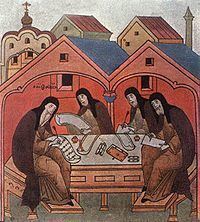Name Epiphanius Wise | Died 1420 | |
 | ||
Epiphanius the Wise (Russian: Епифаний Премудрый) (died 1420) was a monk from Rostov, hagiographer and disciple of Saint Sergius of Radonezh.
He wrote hagiographies of both Saint Stephen of Perm and St. Sergius. The latter, The Life of Sergii Radonezhsky, he started to write a year after the death of Saint Sergius according to his own memories. He finished the writings 26 years after the death of Sergius, i.e., around 1417-1418. There was a rewriting of the work by Pachomius the Serb (Пахомий Серб), which is usually more readily available.
Epiphanius was interested in portraying an idealized account of sanctity, and did so through lengthy panegyrics. His literary style was given the name pletenie sloves, or "the weaving of words", and is marked by an abundance of neologisms, in which Epiphanius liked to form a large number of noun or adjective-noun combinations.
Serge Zenkovsky hails Epiphanius' writings as "a new page in Russian literary history". It is often thought that Epiphanius' new style was influenced by the contemporary surge in Russian painting, and it has been noted that Epiphanius was a great admirer of Theophanes the Greek.
Epiphanius travelled extensively in the East, and is known to have visited Constantinople and the Mount Athos monastery complex.
He died bearing the ranks of a hieromonk and a confessor of the Troitse-Sergiyev monastery.
